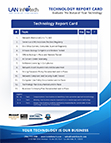If you’re the owner or CEO of a small business, then you’re probably already functioning as the Chief Information Officer (CIO) as well. Most small businesses can’t justify paying for both. This means you have to take time from your priorities to manage your technology, ensure that it’s secure and decide what IT solutions to use. It’s not as easy to do this as it was in years past, simply because of the fast-evolving nature of technology, and the increasing incidence of hacking and data breaches.

But, did you know that you can “hire” a Virtual CIO (vCIO) at a fraction of the cost of hiring a CIO?
What is a vCIO?
A virtual CIO is a technology service provider who serves as your CIO. They help you develop an IT Strategic Plan, with up-to-date resources to ensure security, productivity, and efficiency. Rather than hiring your vCIO, you pay for the service on an on-demand basis.
This frees you from the daily worry about technology and whether it will run as it should. It also frees up your limited internal resources and allows your employees to concentrate on their core responsibilities.
A vCIO Will:
- Gain an understanding of both your business and your technology infrastructure and make sure your IT is aligned with your business goals.
- Help you with IT budgeting and cost control strategies to achieve your priorities and avoid unnecessary costs.
- Analyze any inefficiencies in your existing IT infrastructure and centralize/consolidate resources and operations to promote considerable financial savings.
- Advise on Organizational IT Design and replace outmoded processes so you can pursue market opportunities and overcome business challenges through updated, value-based technologies.
- Effectively incorporate technology into your operational processes and ensure security at all times.
- Develop and IT Strategic Plans that aligns with your budget.
- Learn about your competition, and what new IT solutions they are using.
- Interface with your managers and users to ensure that you meet your IT goals.
- Identify and evaluate the impacts of your technology decisions.
- Conduct ongoing evaluations to assess your IT needs and provide service performance metrics.
- Manage technology needs for specific projects, whether they are new ones or ongoing.
- Deliver monthly updates to your management, provide Quarterly IT Summaries that reveal the condition of each component of your network, and prepare other reports as required.
- Provide procurement assistance to ensure you get the best prices on hardware and software.
Your Virtual CIO Will Help Your Achieve These 10 Technology Priorities for 2018.
Cybersecurity
Security is an essential factor for any organization, and small businesses like yours are the biggest target for hackers today. Risk assessment, data protection, training awareness, and third-party security practices are necessary to ensure maximum security and protection. Continuous diagnostic monitoring is required to view your network, identify risks, quantify attacks and/or breaches, and mitigate them. Digital forensic tools are especially important for companies that require regulatory compliance and incident management. Identity and access management is a security practice that enables only authorized individuals to access resources to comply with security and compliance requirements. These are crucial elements for any business. Your vCIO will manage all these and other cybersecurity requirements for your business.
Disaster Recovery and Business Continuity
Disaster recovery and business continuity refer to your organization’s ability to recover data after a disaster occurs and when IT services are shut down or compromised. Both practices involve the process of backing up data and preparing policies and procedures to implement in the event of a disaster. Your vCIO will confirm your business can stay up and running no matter the IT disaster, manmade or natural.
Mobile Workforce Technologies and Solutions
With the BYOD (bring your own device) trend, organizations are using mobile devices more than ever. Your business is competing in a mobile, technology-driven economy, and you must rely on your mobile workforce to ensure customer satisfaction and product/service innovation. The right mobility solutions ensure secure and simple access to data, tools, and applications from any location. Your vCIO will help you consider applications, support, ownership, security, and communication issues and policies that will ensure your mobile workforce is always productive, and your data is secure.
Cloud Computing, Software as a Service (SaaS) and Virtualization
Software as a Service utilizes a cloud-computing infrastructure to deliver a single application to your employees no matter their location. This is opposed to relying on the traditional one application per desktop. Cloud services are available to your employees via the Internet from a cloud provider’s servers and used instead of your company’s own on-premises servers. Virtualization refers to the creation of virtual servers, desktops, storage devices, applications, and computer network resources. You can virtualize your entire IT infrastructure or just specific aspects of it. Cloud services and virtualization provide easy, quick, scalable access to resources, applications, and services, and simplifies your overall IT infrastructure to promote efficiency.
Enterprise Resource Planning (ERP)
Enterprise Resource Planning involves the use of business management software that combines a variety of integrated applications to store and manage data for all aspects of your business operations. It includes product planning, manufacturing, marketing, inventory management, shipping, invoicing, accounts receivables and payables, and more. Software as a Service Enterprise Resource Planning (SaaS ERP) supports remote hosting of business IT services. It’s also known as Cloud Enterprise Resource Planning (Cloud ERP).
Strategic IT Planning
Strategic IT planning focuses on your organization’s specific needs and how to best use technology to meet them. IT is a strategic capability to be used and integrated into planning and projections with consideration of future IT innovations and business growth. Your vCIO will work with you to determine how technology will help you achieve your business priorities and prepare guidelines and policies that support your vision with the right IT solutions.
Networking: Data and Voice Communications
Data communications refer to the electronic transmission of information for storage and processing, while voice communications refer to systems such as mobile devices and VoIP systems. Your vCIO will help you implement the best communication solutions to keep your organization connected and up and running.
Legacy Application Modernization/Renovation
Legacy application modernization is the process of refactoring, re-purposing, or consolidating legacy software programs to align with a company’s current needs. This enables you to benefit from the advantages of new development without the risk and cost of replacing legacy systems.
Business Intelligence and Analytics for Big Data
Business intelligence, or BI, is a term that refers to a variety of software applications used to analyze an organization’s raw and big data (massive amounts of data). Business analytics is the process of exploring and investigating an organization’s data with emphasis on statistical analysis. This is becoming more important for even small businesses today. They are relying on software solutions like Microsoft Power BI (Business Intelligence) to transform data and create interactive reports to help them analyze data to reach their goals.
Shared Services
Many parts of an organization use the same services and resources. Shared services involve the consolidation of business services and resources used by multiple parts of an organization. For example, with service portfolio management, organizations can define and manage services and resources. By incorporating automation, virtualization, advanced analytics, and other digital technologies into your operations, you can streamline processes. These technologies also may enable you to make better decisions and improve the quality of customer interactions.
By taking advantage of the services a virtual CIO provides, you’ll enjoy all the benefits of a CIO without the added costs. Your vCIO will protect your important data, help you get the most from your technology budget, provide customized reports and recommendations, and ensure you meet the technology challenges of 2018 and beyond.

LAN Infotech is a Microsoft Cloud Services Provider, IT Managed Support company and a leader in helping law firms, nonprofits and medical organizations deploy cloud solutions, manage computer networks, keep data protected and top technology management company. Businesses like yours need technology support to run highly-effective organizations.


